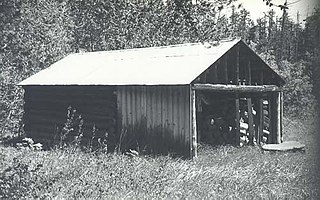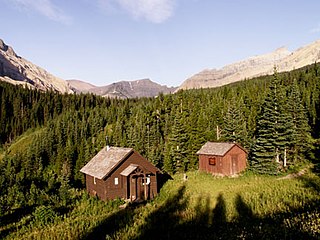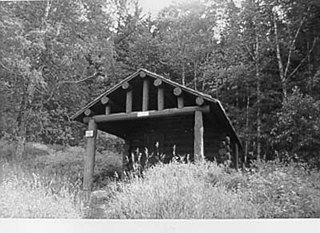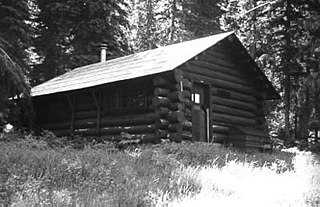The Moran Bay Patrol Cabin was built by the Civilian Conservation Corps about 1932. The log structure was located in the northern backcountry of Grand Teton National Park, and was built to a standard design for such structures, in the National Park Service Rustic style, but for the U.S. Forest Service, which administered much of the area prior to the expansion of the park in 1943. The Upper Granite Canyon Patrol Cabin is similar.

The Upper Granite Canyon Patrol Cabin was built by the Civilian Conservation Corps about 1935. The log structure is located in the extreme southwest backcountry of Grand Teton National Park. The cabin was built according to a standard design for such structures, in the National Park Service Rustic style. The Moran Bay Patrol Cabin is similar.

The Many Glacier Campground Camptender's Cabin in Glacier National Park is an example of the National Park Service Rustic style. Built in 1934, the small cabin is significant for its association with park visitation patterns, auto camping, and NPS rustic architecture.

The Lee Creek Snowshoe Cabin was built in Glacier National Park in 1925–27 by Austin Swikert as a shelter for winter hikers. The log structure consists of a single room with wood floor, unfinished walls and roof. A trap door in the floor provides access to a small cellar food cache. There is a woodstove with metal chimney.

The Kootenai Creek Snowshoe Cabin was built in Glacier National Park in 1926. The rustic log structure comprises a single room with a woodstove, and a small cellar food cache. The cabin was situated on the patrol route from the Goat Haunt ranger station to the Fifty Mountain-Flattop region, about eight miles upstream from the ranger station. Unlike most patrol cabins, it is isolated from the park's main trail routes.

The Lower Nyack Snowshoe Cabin, built in 1927 in Glacier National Park, is a significant resource both architecturally and historically as a shelter about one day's travel north of the Theodore Roosevelt Highway for patrolling backcountry rangers. The design originated at Yellowstone National Park, adapted in this case with a somewhat larger size.

The Upper Nyack Snowshoe Cabin, built in 1926 in Glacier National Park, is a significant resource both architecturally and historically as a shelter, usually 8–12 miles apart, for patrolling backcountry rangers. The design is similar to that used in Yellowstone National Park, which was in turn adapted from U.S. Forest Service shelters, which were themselves adaptations of trapper cabins. Upper Nyack retains some original interior furnishings, including hanging beds.

The Coal Creek Patrol Cabin in Glacier National Park, Montana, is a rustic backcountry log cabin. Built in 1925, the cabin has a single room with a board floor and a small cellar for a food cache. The cabin was used by rangers on patrol routes from the Nyack and Paola ranger stations.

The Pass Creek Snowshoe Cabin, built in 1938 in Glacier National Park, is a significant resource both architecturally and historically as a shelter, usually 8–12 miles (13–19 km) apart, for patrolling backcountry rangers.

The Lower Logging Lake Snowshoe Cabin and Boathouse were built in 1933 in Glacier National Park near the southwestern end of Logging Lake. The National Park Service Rustic boathouse stores rangers' canoes for patrolling the lake and their journeys between Upper and Lower Logging Lake patrol cabins. The Lower Logging Lake snowshoe cabin is nearby. They are a significant resources both architecturally and historically, constructed for backcountry patrols.

The Ford Creek Patrol Cabin in Glacier National Park was built in 1928. The National Park Service Rustic log structure was a significant resource both architecturally and historically as a network of shelters, approx. one day's travel apart, for patrolling backcountry rangers.

The Quartz Lake Patrol Cabin in Glacier National Park is a significant resource both architecturally and historically as shelters, one-day's travel apart, for rangers patrolling the backcountry. The National Park Service Rustic log cabin was built in 1930 by local builder Austin Weikert, using National Park Service standard plan G913. The cabin is adjacent to the western shore of Quartz Lake.

The Upper Logging Lake Snowshoe Cabin was built in 1925 in Glacier National Park. The National Park Service Rustic as a shelter for rangers patrolling the backcountry. The design is similar to that used in Yellowstone National Park, which was in turn adapted from U.S. Forest Service shelters, which were themselves adaptations of trapper cabins.

The Lower Park Creek Patrol Cabin in Glacier National Park is a rustic backcountry log cabin. Built in 1925, the cabin has a single room. The design originated at Yellowstone National Park.

The Upper Park Creek Patrol Cabin in Glacier National Park is a rustic backcountry log cabin. Built in 1928, the cabin has a single room. The cabin was built to National Park Service design G913, and adaptation of cabins used at Yellowstone National Park, which had been modeled on those used by the U.S. Forest Service, which in turn were derivations of backwoods trappers' cabins. The Upper Park Creek cabin was more difficult than most to construct, due to its high, remote location.

The Slide Lake-Otatso Creek Patrol Cabin and Woodshed in Glacier National Park are a small group of rustic buildings in the park's backcountry. Built in 1936, the patrol cabin is a frame building, unlike the more typical log patrol cabins found throughout the park. The similar woodshed is nearby. The cabin's proximity to the Alpine-themed Many Glacier Hotel may have influenced the decorative detailing, which is unique in Glacier. The only other frame patrol cabin is the Fielding Cabin, in the southern part of the park. The cabin was completely reconstructed in the 1980s "to thwart a particularly aggressive pack rat population". The buildings are located along Otatso Creek, 1.25 miles (2.01 km) downstream from Slide Lake.

The Upper Kintla Lake Patrol Cabin in Glacier National Park is a rustic backcountry log cabin. Built in 1931 to standard National Park Service plan G913, the cabin has a single room. The cabin was modeled after similar cabins used at Yellowstone National Park, which were in turn similar to those used by the U.S. Forest Service, which resembled trappers' cabins. The Upper Kintla Lake Patrol Cabin is actually situated on the eastern shore of Kintla Lake which is almost 2 miles (3.2 km) west of Upper Kintla Lake.

The Logan Creek Patrol Cabin in Glacier National Park is a rustic backcountry log cabin. Built in 1925, the cabin has a single room. It is unusual among Glacier's patrol cabins in lacking a covered porch to offer sheltered firewood storage and protection for the entrance.

The Wonderland Trail is an approximately 93-mile (150 km) hiking trail that circumnavigates Mount Rainier in Mount Rainier National Park, Washington, United States. The trail goes over many ridges of Mount Rainier for a cumulative 22,000 feet (6,700 m) of elevation gain. The trail was built in 1915.

The Thunder Lake Patrol Cabin is a small structure in Rocky Mountain National Park, Colorado. Built in 1930, the 12-foot (3.7 m) by 16-foot (4.9 m) cabin may have been built as a simple shelter, but has more recently been used on an occasional basis as a backcountry patrol cabin in the Wild Basin area. The one story one-room log cabin is not used in the winter, but does have a stove with a stone fireplace. The main cabin is gable-roofed, with a small shed-roofed porch, and is a good example of the National Park Service rustic style. The logs are saddle-notched, projecting an increasing distance at their ends from top to bottom.




















